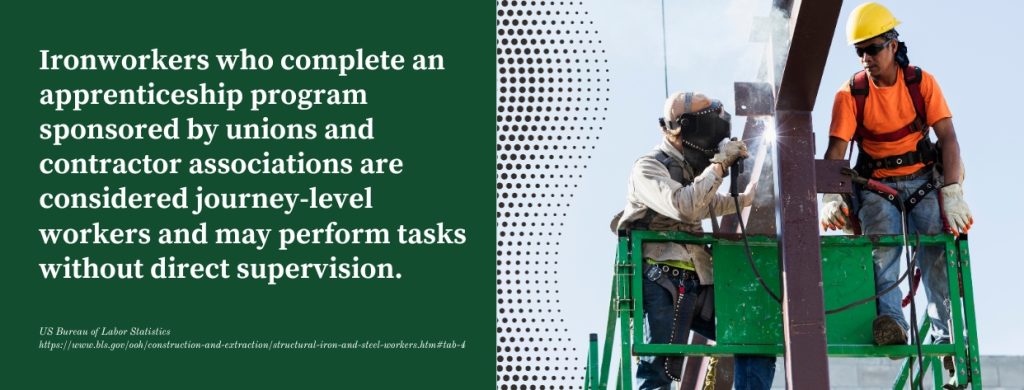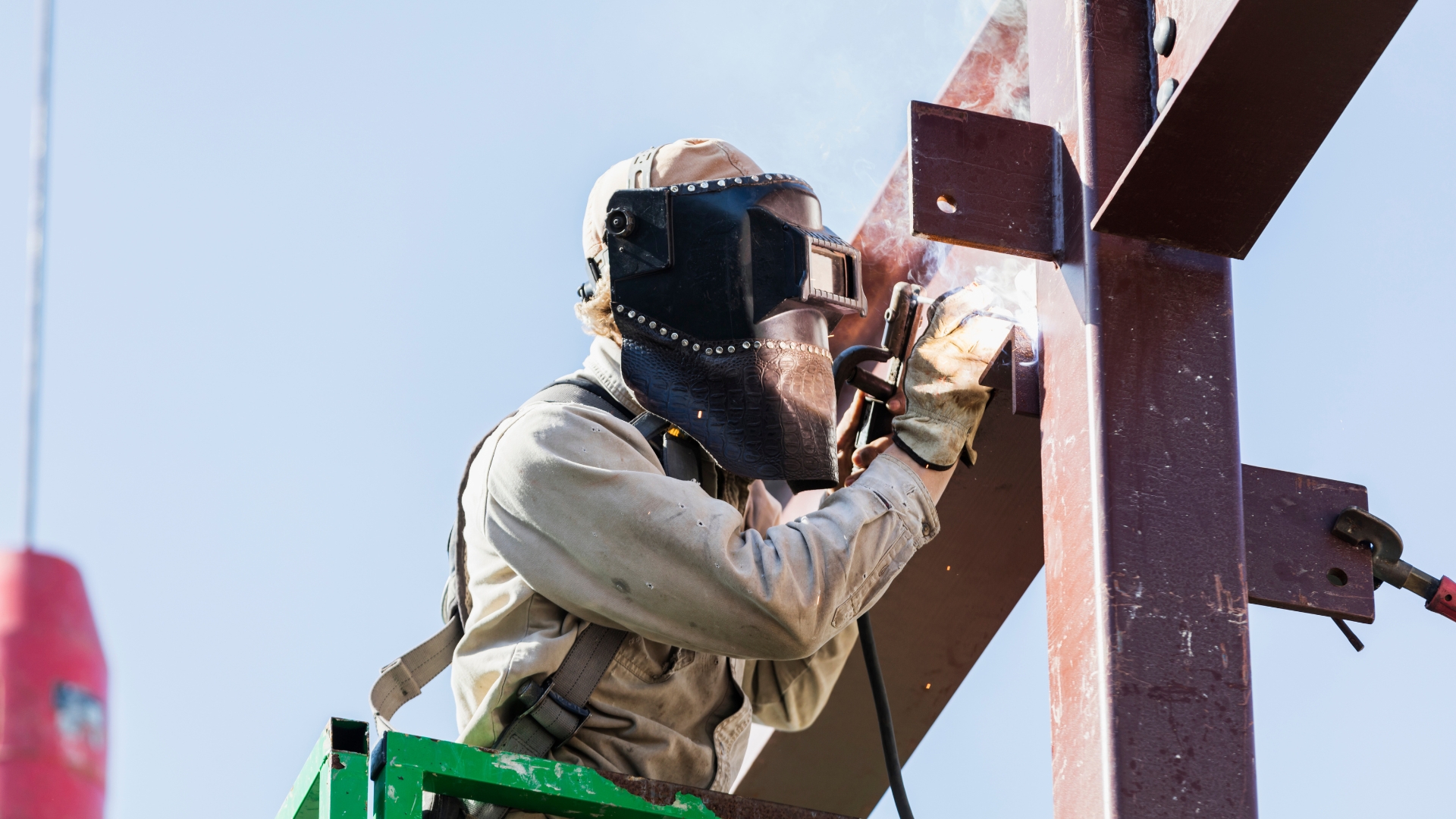Advancements in technology have revolutionized how humans do things. Constructing buildings, for example, has become quite complex nowadays, thanks to the new way of assembling structural steel framework, which is the backbone of all kinds of infrastructures.
While construction has now become more intricate, it has also become safer and more durable, no matter how tall or robust buildings, bridges, or other infrastructures are.
One of the factors that make all that possible is ironwork.
What Is an Ironworker?
An ironworker smelts and makes heavy iron and steel products. Journeyman ironworkers keep rewarding careers that involve installing structural and reinforcing steel and iron to support and form roads, bridges, buildings, and other infrastructures.
Duties of Ironworkers
Ironworkers specialize in installing steel and iron frames for the construction of buildings, roads, bridges, and other infrastructures. Their tasks primarily involved the following:
- Perform field welds on iron and non-iron metals using Gas Metal Arc Welding (GMAW), Gas Tungsten Arc Welding (GTAW), Flux-Cored Arc Welding (FCAW), and Shielded Metal Arc Welding (SMAW).
- Layout and fabricate structural steel and sheet metal to build metal structures like stadiums, bridges, and structural buildings.
- Align reinforcing and structural iron and steel horizontally and vertically using plumb bobs, levels, lasers, and tag lines.
- Use torches, hand tools, torches, rod-bending machines, and welding equipment to cut, weld, and bend reinforcing and structural iron and steel.
- Place, erect, and join steel columns, girders, and other parts to form structural frameworks.
- Assemble precut metal buildings, derricks, and cranes that move equipment and materials around the construction site.
Ironworker Job Outlook in the US
It has been estimated that the overall employment of ironworkers will grow by 2% from 2022 to 2032, which is about as fast as the average for other jobs. This means that there will be 8,100 job openings for ironworkers every year, on average, until 2032.
The following are the industries with the highest number of employed structural iron and steel workers:
- Building equipment contractors
- Fabricated metal product manufacturing
- Nonresidential building construction
- Foundation, structure, and building exterior contractors
- Iron and steel mills and ferroalloy manufacturing
- Highway, street, and bridge construction
- Other heavy and civil engineering construction
- Other specialty trade contractors
States that offer the highest salaries for ironworkers:
- New Jersey – $95,250
- Massachusetts – $94,130
- New York – $93,470
- Illinois – $92,000
- Washington – $84,630
The Labor Statistics Bureau estimates that there are 66,810 employed structural iron and steel workers in the nation, earning a median hourly pay of $29.09 or a median annual wage of $60,500
Methodology
We have included schools that offer online, hybrid, and on-campus training and certificate programs to provide interested students with a wide range of options.
Here are the criteria we used to select each of the best community colleges and trade schools with ironwork apprenticeship and training programs:
- Courses are offered fully online, partly web-based, or in-person to ensure learners will be able to customize their schedule with their training or certificate program.
- The curriculum covers a broad range of topics in ironworking to provide students with a strong foundation in the field.
- Blends classroom and shop instruction, so that students apply theoretical knowledge through practical learning experiences, including in iron workers apprenticeship program opportunities, on-campus lab work, or virtual scenarios that hone their ironworking skills.
- Ensures the total cost of tuition and fees is affordable and accepts financial assistance to make skill education more accessible for everyone.
- Has proper accreditation from recognized organizations, including the National Center for Construction Education and Research (NCCER), to ensure the quality of the training program.
Top 5 Ironworker Trade Schools
Washtenaw Community College

- Location: Ann Arbor, Michigan
- Delivery Method: Online
- Time It Takes to Complete: 1 semester
- Completion Rate: undisclosed
- Types of Aid: Federal Grants, Loans, Scholarships, Military Educational Benefits, Work-Study Program
Washtenaw Community College has an Ironworkers Pre-Apprenticeship Certificate program that introduces students to the essential skills necessary to become Union Ironworkers across the United States and Canada.
This program produces journeymen ironworkers qualified for about print reading, welding, and safety processes used by the industry. Those who complete the program will be eligible for advanced standing in the Ironworker Local Union Apprenticeship Training Program. This ironworker apprenticeship program is a project of the Department of Apprenticeship and Training and The National Training Fund.
Mid-State Technical College

- Location: Adams, Wisconsin; Marshfield, Wisconsin; Stevens Point, Wisconsin; Wisconsin Rapids, Wisconsin
- Delivery Method: Distance Learning
- Time It Takes to Complete: 3-4 years
- Completion Rate: undisclosed
- Types of Aid: Federal Pell Grant, Federal Supplemental Educational Opportunity Grant (SEOG), Wisconsin Grant, Talent Incentive Program Grant (TIP), Wisconsin Indian Grant, Federal Stafford Subsidized Loans, Federal Stafford Unsubsidized Loans, Parent Loan to Undergraduate Students (PLUS)
Through Mid-State Technical College’s Ironworker Apprenticeship program, individuals who are looking to become ironworkers will learn how to produce, erect, fabricate, and construct the metal parts of bridges, buildings, and other structures.
They will know how to use bronze, iron, ornamental lead, steel, and the like in the erection of commercial, industrial, and large residential buildings.
Ironworker in apprenticeship training will also be taught to erect the steel framework of buildings, bridges, and other infrastructures, such as overhead crane runways and metal storage tanks, to name a few.
Community College of Allegheny County

- Location: Pittsburgh, Pennsylvania
- Delivery Method: In-Person
- Time It Takes to Complete: 3 years
- Completion Rate: undisclosed
- Types of Aid: Direct Federal Stafford Subsidized and Unsubsidized Loans, Direct Parent PLUS Loans
At the Community College of Allegheny County, students interested in learning about ironworking can enroll in its Ironworker Apprenticeship program, which provides them with occupational training sponsored by the local Joint Apprenticeship Committee. This program is a combination of lecture and laboratory classes that are equivalent to 45 credits.
Students enrolled in this program will train to become skilled ironworkers working in commercial building construction. They will know how to work safely in all aspects of the ironworking trade as defined and governed by the American National Standards Institute (ANSI) and the Occupational Safety and Health Administration (OSHA).
This program is offered in conjunction with the Joint Apprenticeship Committees of the Pennsylvania Department of Labor. At the end of the program, the state of Pennsylvania awards working papers.
North Seattle College

- Location: Seattle, Washington
- Delivery Method: In-Person
- Costs: undisclosed
- Time It Takes to Complete: 4 years
- Completion Rate: undisclosed
- Types of Aid: Federal Pell Grant, Federal Supplemental Educational Opportunity Grant (FSEOG), Washington State Grants, Scholarships, Federal Direct Loans, Alternative Educational Loans, Veteran’s Assistance, Workforce Education, Student Emergency Assistance, AmeriCorps Educational Award, WA Guaranteed Education Tuition
North Seattle College offers the Ironworkers Local 86 Apprenticeship program, which offers a special opportunity for individuals to receive hands-on training in a field that will pave the way for them to land high-paying jobs while in training.
This Ironworkers apprenticeship program will train students to erect structural frameworks of high-rise buildings, power plants, towers, and bridges, to name a few. They will also know how to place reinforcing steel in concrete forms for foundations, roadways, bridges, and other structures. More importantly, they will develop their skills in rigging, machinery moving, ornamental, and welding.
This apprenticeship program is a combination of classroom learning and on-the-job training, which is supervised by a trade professional or journey-level craftsperson. One of the benefits of enrolling in an Ironworkers Local 86 apprenticeship is that students are paid $25.41 per hour, which increases every six months throughout the training program.
This means that apprentices can earn a living with retirement, healthcare, and other benefits while building their trade skills.
Mt. Hood Community College

- Location: Gresham, Oregon
- Delivery Method: In-Person
- Time It Takes to Complete: 4 years
- Completion Rate: undisclosed
- Types of Aid: Federal Pell Grant, Federal Supplemental Educational Opportunity Grant (SEOG), Oregon Promise Grant, Oregon Opportunity Grant, Scholarships, Work-Study Program, Direct Loans, Alternative Student Loans,
Mt. Hood Community College offers an Ironworkers Apprenticeship program that Union Ironworkers and employers sponsor. It is a four-year program that has classes that are conducted in the classroom and on-site. Apprentices will attend four-week training sessions every year of the program and, at the same time, earn 65% of the journey-level wage.
Through this program, students will learn how to erect structural frameworks for high-rise buildings, power plants, towers, and bridges. They will be trained to place reinforcing steel in concrete forms to make foundations, roadways, bridges, and more.

Frequently Asked Questions about Ironworker Trade Schools
How does one become a journey-level ironworker?
To be able to train to become an ironwork apprentice, interested individuals need to have a high school diploma or equivalent. Once they are accepted in an apprenticeship program, they will undergo on-the-job training and learn about blueprint reading and welding, cutting, and fabricating iron and steel.
The apprenticeship program may last between three and four years. Apprentices need to render at least 144 hours of technical instruction plus 2,000 hours of paid on-the-job training.
Some also pursue the associate degree, which highlights academic knowledge and grants graduates an undergraduate diploma after completing what would be equivalent to a four-year apprenticeship program.
What certifications do ironworkers need to have to enter the field or advance in their careers?
The Ironworker Management Progressive Action Cooperative Trust (IMPACT), a joint, nonprofit trust that brings together the best contractors, apprenticeship partners, and top ironworkers in the United States, recommends two certifications for the journeyman ironworker.
- Ironworker Rigger and Signal Person Certification. This certification ensures that only trained and skilled ironworkers perform signaling and rigging tasks, reducing workplace risk.
- Welding Certification Program. This provides ironworkers with a Welding Performance Qualification Test Record (WPQR) and photo certification for identification purposes. Every card also indicates the specific welding process that an ironworker has qualified for, allowing employers to verify their skills.
For more valuable information, see the following:

